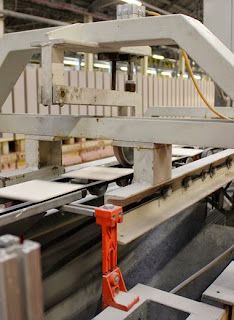Porcelain Tiles Production Tour
The factory located in Foshan, China and have separate facilities focused on their two main application areas: walls and floors. Both facilities employ a parallel process with slight variations, optimising the products for the requirements of their specific applications.
Production begins with the purchasing of high quality ingredients: clays, kaolin, quartz, magnesite and sand. Two inspections are carried out on the ingredients before being stored in the raw materials area. In line with the factory`s environmental commitment, all raw ingredients are quarried within 450km of the production facility, minimising their energy consumption due to transportation while also supporting the region's economy.
The raw materials are mixed and loaded into a 30m tall hopper that lays the ingredients onto a conveyor belt, delivering them into large drums used for further mixing and grinding. These steel drums contain 30mm porcelain balls, which, by rotating the drums, grind the ingredients into a fine powder over an 8-10 hour cycle.
The freshly ground powder is mixed with wet clays into a slurry and stored in a vast lake directly beneath the factory floor. The slurry is sieved and vibrated, so that only particles of the correct size are taken to the next stage. The mixed and graded ingredients are then fed back into a heated hopper, drying them once more to a powder with the correct moisture content.


Pressing
The powdered ingredients are dropped onto a die, which gives each tile its overall shape, vibrated to remove any air bubbles and then pressed into a 'green' (an unfired tile). Pressing occurs at over 400 kgs/cm2, creating a dense and high strength product once fired. As the pressure must be applied uniformly across the tile, larger formats become increasingly challenging to produce to the required quality, as demonstrated by their increased price.
This facotry`s current maximum capabilities are 60 x 120 cm or 90 x 90 cm formats, with the intention to increase this further in the near future.
All HudsonChina`s products use the same standardised base composition, combined with pre-mixed batches of minerals and pigments, to allow speed and flexibility in producing different surfaces or ranges.
During the pressing stage Mosa employ their proprietary Ultragres technology for floor tiles, a system that produces an ultra hard, ultra low porosity 3mm wear layer. A layer of finely ground powder is dropped on top of the base mixture then pressed together into a unified product. This powder drop technique introduces variation to the appearance of the wear layer, ensuring the tiles share common characteristics yet each is unique, similar to products that display natural variation.
The unfired 'greens' are collected on 'roller boxes', each holding approximately 200 m2 of tiles, and transported to the next stage of the production by 'TGV' autonomous transportation units.
Firing
Firing is the next operation in production, where the 'greens' metamorphose into hard and high strength porcelain tiles. As a consequence of when their equipment was purchased, We have two kiln types in firing: traditional brick kilns and a modern conveyor 'mono-fire' kiln.
In the brick kiln 60m2 of tiles are stacked onto trolleys and gradually passed through the kiln over a period of 2-3 days. The brick kilns are primarily used for producing small format tiles, which can fall between the rollers of a modern kiln. Recovery of dropped tiles and kiln maintenance can be dangerous and difficult, exacerbated by the fact the kiln itself can never be switched off.
The modern kilns operate a process of 'mono-firing' where the tiles are stacked individually and gradually moved through the kilns, experiencing a precisely controlled temperature cycle. Firing occurs over a period of 45 – 80 minutes, reducing firing times by a factor of over x50 in comparison to traditional kilns. The kilns are gas fired, reaching peak temperatures of 1220oC.
Each tile size has a specific heating and cooling curve, requiring the kilns to be re-calibrated each time the format size being produced is changed. To minimise this disruption, runs of 4000m2 are produced before changing formats.
Following firing the tiles are fed onto a conveyor belt for quality control. A wheel applies pressure to the tile surface, cracking the tiles with imperfections and removing them from the production line to be collected for later recycling.
Quality control wheel applying pressure to each tile's surface,
causing any tiles with defects to crack and be removed
Glazed wall tiles are passed through a waterfall of liquid glaze, which is applied in a two stage process to ensure consistent coverage. Any prints and textures are subsequently roll-applied onto the wet glaze and the tiles are sent back for the second firing phase.
Once cooled the tiles are rectified, ensuring the edges are perfectly squared and the tile's dimensions exact, and a micro-bevel is added to the edge using diamond-tipped tools. Rectification is carried out on all tiles larger than 45 x 45 cm. This is a necessary process as the pressed 'greens' are manufactured larger than necessary to accommodate the shrinkage that occurs during firing.
The micro-bevel is added to increases the longevity of the product by minimising the risk of spalling, the process whereby the vulnerable sharp corner formed between tile surface and edge chips through wear and tear.
The finished tiles are once more inspected for visual quality and imperfections before being packaged and stored for distribution. Their strict attention to quality control has led HudsonChina to achieve design tolerances 50% better than the requirements of US standards.












No comments:
Post a Comment